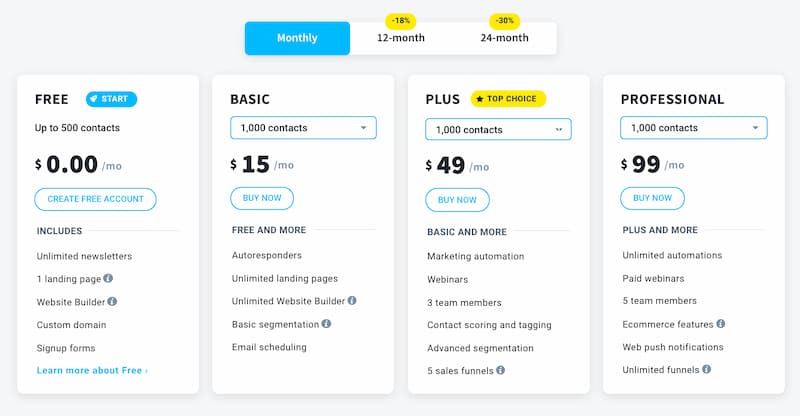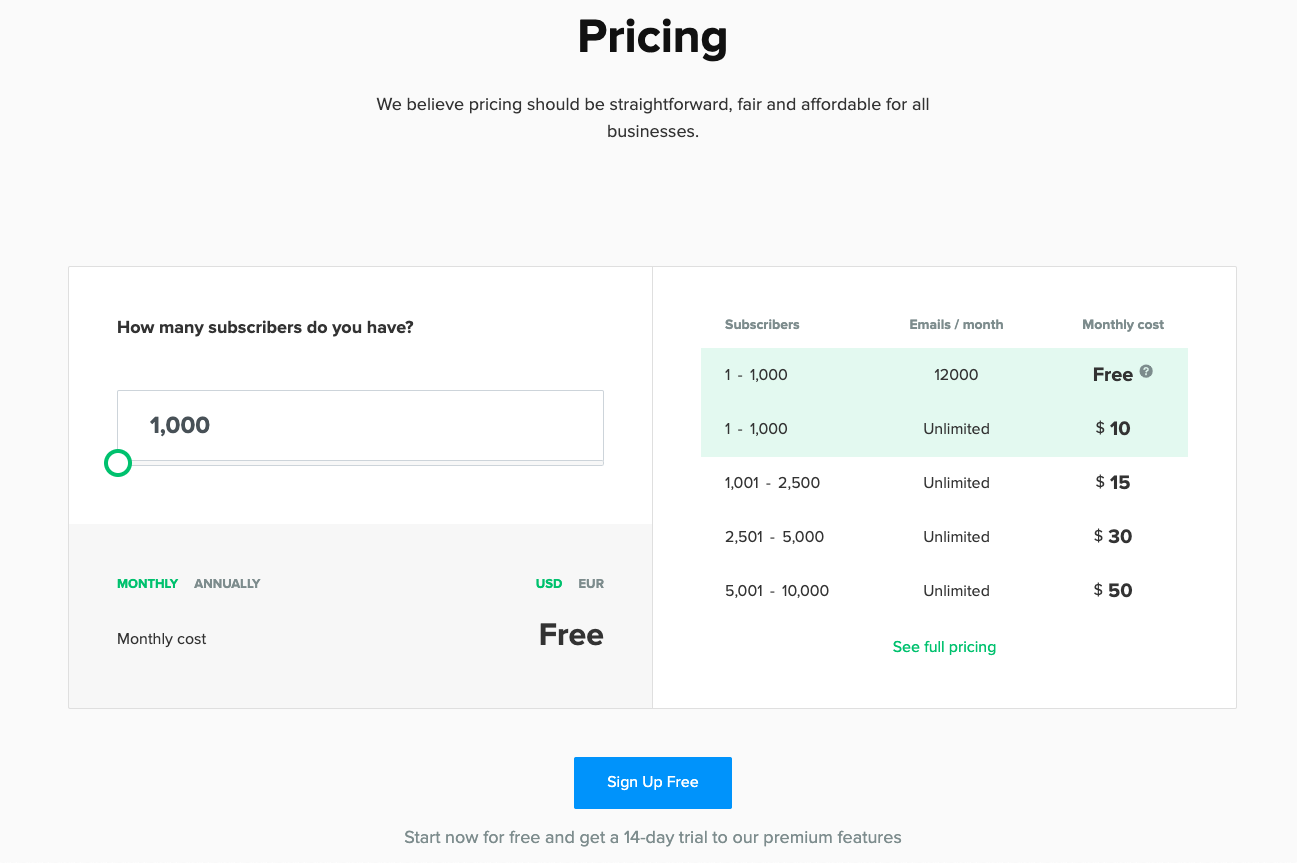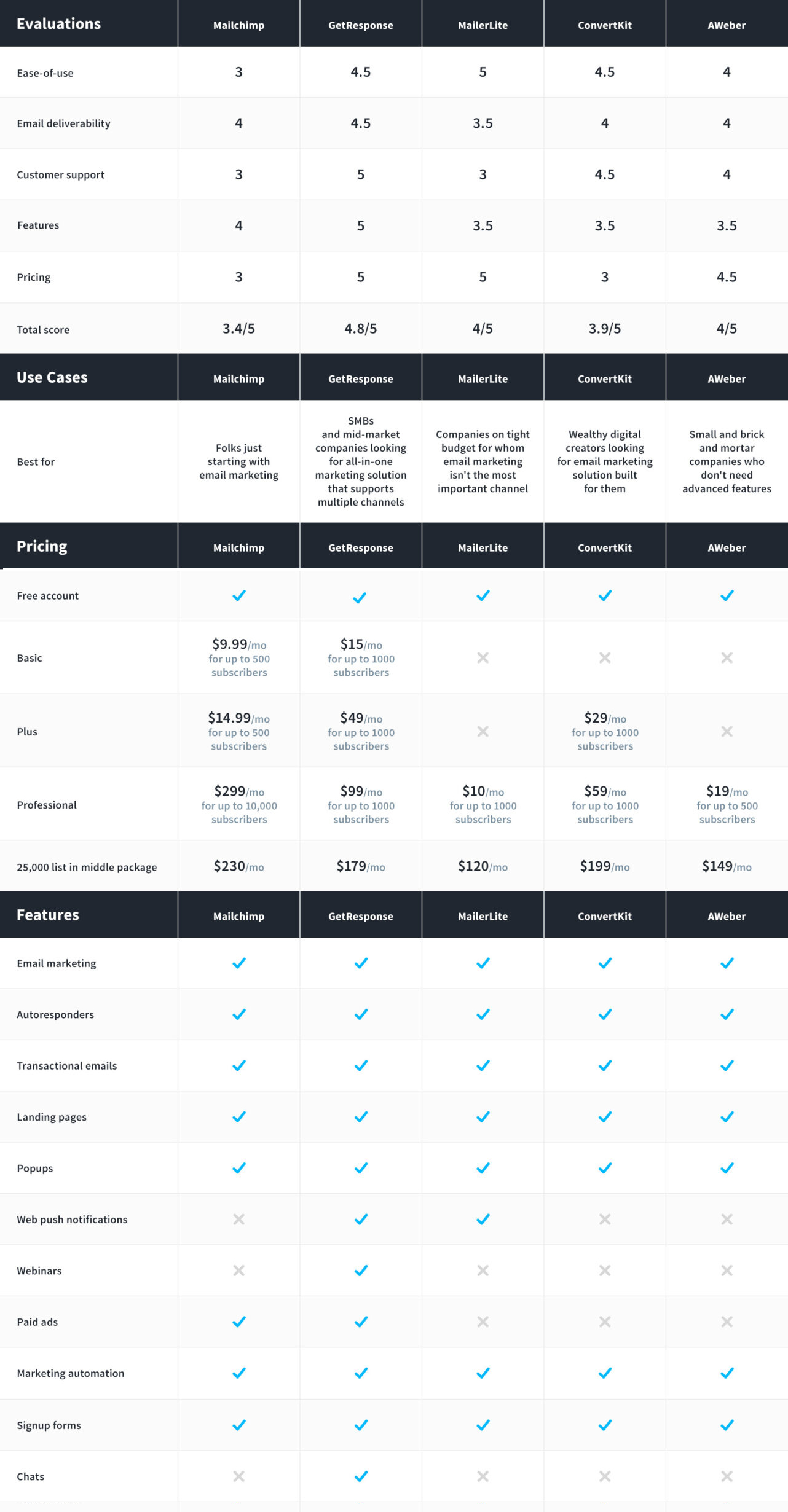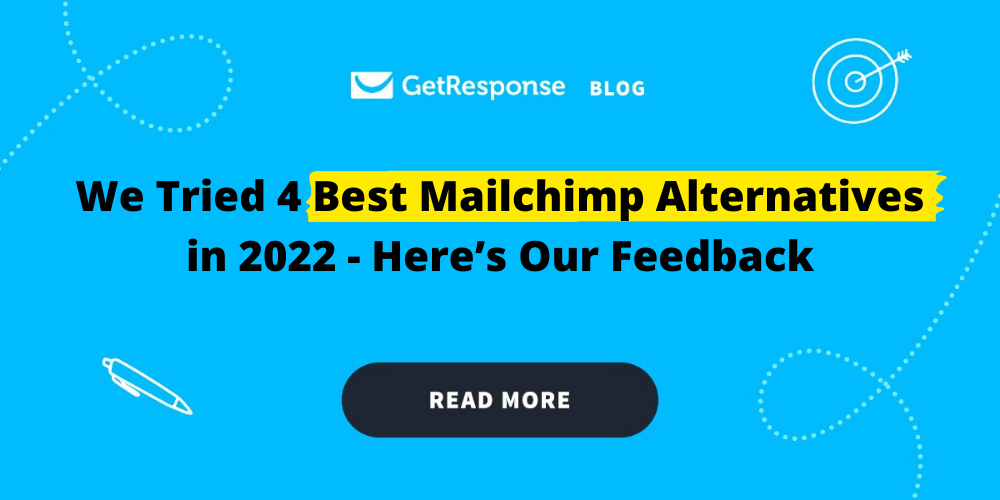No products in the cart.
Email Marketing
We Tried 4 Greatest Mailchimp Options in 2022 [Key Takeaways]
The fact that you’re reading this article means that you’re currently using Mailchimp, but it doesn’t fit your needs.
Or perhaps you’re not feeling too happy about their acquisition from Intuit?
You’re looking for something better, that’s more cost-effective and with more functionalities and features.
Don’t get me wrong – Mailchimp is an excellent product. It’s one of the pioneers in the email marketing space. But over the years, it became a giant, old dinosaur that brings you more pain than pleasure.
Fortunately, you don’t need to spend dozens of hours and your energy on finding the perfect Mailchimp alternative.
We did the heavy-lifting for you. We went out, tried, and tested the four best Mailchimp alternatives on the market.
We used each tool for about a week and got to know the software in and out.
The alternatives we have tested are:
- GetResponse
- MailerLite
- ConvertKit
- AWeber
In this article, we will share our in-depth feedback and thoughts on each of these Mailchimp alternatives.
We even went one step further, and unlike other review articles on the subject, we evaluated each product by specific criteria. This will help you to easily compare multiple alternatives and find the right fit for you.
The criteria we used are:
- Ease of use
- Email deliverability
- Customer Support
- Feature Score (How feature-rich some platform is compared to the others)
- Pricing
With no further delay, let’s find the best Mailchimp alternative for you!
If you don’t have time to read our in-depth feedback on all platforms, you can check our Overview section below.
Table Of Contents
Mailchimp alternatives: overview of the best email marketing platforms
Overall comparison
Mailchimp overview
To understand Mailchimp alternatives, we will quickly look into Mailchimp itself.
As we all know, Mailchimp is one of the most popular email marketing solutions on the market.
It allows you to build landing pages, get email subscribers and send different email campaigns to your users.
But since Mailchimp has been on the market for so long, it became a huge, robust, and complicated platform.
Therefore, Mailchimp isn’t the right fit for everyone.
The six biggest downsides of Mailchimp
Opinions about Mailchimp vary. A lot of people like the product overall, but a lot of others don’t.
Here are the common problems with Mailchimp reported by other users and confirmed by us (after we tested it):
- If you’re importing an email list you’ll need to re-confirm it – using double opt-in is definitely a good list management practice but if you’ve already collected user consent from your subscribers, it shouldn’t be necessary to do it again. If you’re moving your list from another email marketing service, this can cost you a big share of your email database (not everyone will click the confirmation link).
- Affordable at the beginning but expensive once you grow – Mailchimp is often the go-to tool when you’re just starting out. It’s integrated with multiple platforms and offers a free account. But if you want to have access to their support team or even schedule your newsletter ahead of time, you need to go for one of the paid plans – and these become expensive as your list grows.
- You can’t build excellent funnels with its landing page builder – Mailchimp’s landing page builder is a pretty basic one. Not many customization options are offered, and putting all the pieces together within your campaign is pretty challenging.
- Strict email sending limit – Mailchimp limits the number of subscribers you can have in your lists, and that’s okay. However, it also limits the number of emails you can send per month. Within the basic plan, you can send only up to 10 emails per subscriber. For some, this may be enough, but if you’re in a particularly dynamic business then this may not be enough.
- Slow customer service – We’ve got a response to our customer support issue in something over two days.
- Slightly outdated email designs – If you use free email designs and templates, you may find it hard to pick a template that’ll look modern and match your branding. And if you want to custom-code your templates, you’ll need to buy the Standard package.
These are the six primary and most frustrating shortcomings of Mailchimp. Of course, as with every product, many other things don’t work precisely the way we want them to, but let’s not get petty here.
On the other hand, let’s take a look at Mailchimp’s advantages.
Mailchimp’s advantages
The purpose of this article is to give you the most honest feedback on all Mailchimp alternatives and the state of the email marketing software industry.
So let’s not be too critical towards Mailchimp. It also offers some great stuff and has certain advantages.
So, what are the things Mailchimp does well?
- 200+ integrations – With over 200 integrations, it’s easy to integrate your Mailchimp account into your existing workflows and start using it right away.
- Simple email design – Although the existing templates are pretty basic and outdated, it’s effortless to design your emails with its drag-and-drop editor.
- Great for small local businesses – Mailchimp’s free plan is great for small local businesses. It has everything you need to start with email marketing.
- Simple mailing list setup – Although many features are hard to use, it’s very easy to set up your mailing list and send your first email campaigns.
Mailchimp’s pricing
Mailchimp has a free plan that allows you to have 2000 users in your list and send up to 10,000 emails per month. Although the free plan is pretty basic, it’s great for people who are just starting and want a simple tool to send their campaigns immediately.
The minimal pricing plan starts at $9,99/mo for up to 500 contacts.
If you start with the free plan, have 2000 contacts, and subscribe to the basic plan, expect to start paying $30,99/mo.
The Standard plan, for up to 25,000 contacts, costs $230/mo.

Now that we understand Mailchimp, let’s analyse the best Mailchimp alternatives on the market.
Mailchimp’s score

GetResponse – all-in-one marketing solution

We’re well aware that this is our tool, and we don’t want to brag about it. The idea of this article is to present you with an objective view of the best Mailchimp alternatives.
GetResponse is one of them, but we will take an objective approach for all of the reviewed tools, including ours. We will cover GetResponse’s shortcomings and advantages as well.
Let’s get back to the topic.
GetResponse is the all-in-one marketing solution for small, medium, and enterprise businesses.
It has everything you can imagine to build frictionless sales funnels, grow your newsletter, and send different email campaigns.
So let’s dive into GetResponse.

Seven advantages of GetResponse over Mailchimp
Unlike Mailchimp, GetResponse is an all-in-one platform that offers you more functionalities.
With GetResponse, you can engage with your customers on various channels:
- Google & Facebook ads
- Landing pages/sales pages
- Web push notifications & popups
- Webinars
- Chats
and others.
Mailchimp offers some of these channels, but the difference is that GetResponse implemented all of this more intuitively.
In other words, with GetResponse, creating landing pages, getting subscribers, and making your autoresponders or email campaigns is way easier than with Mailchimp.
Here are the most significant advantages of GetResponse:
- Ease of use – GetResponse aims to deliver the best UX possible. We make sure that with our product, you become a marketer superhero.
- Robust platform – GetResponse has you covered through every step of your journey, from the essential email campaigns to creating complex sales funnels that bring immense conversions.
- Excellent customer support – When we reached out to our customer support reps through live chat without them knowing it’s us, we got a response in less than 1 minute.
- Multi-language support – The platform’s available in 26 languages, so if English isn’t your native language you can still launch effective marketing campaigns with ease.
- Optimised for getting more sales – GetResponse has a unique feature we call Conversion Funnels. It allows you to create your entire sales funnel, from getting traffic through paid ads and getting subscribers to nurturing your subscribers with various autoresponders, transactional emails, or ordinary email campaigns.
- Unlimited emails – Unlike Mailchimp, with GetResponse, you can send an unlimited amount of emails to your subscribers, no matter the package you choose or the size of the list you have.
- Cost-effectiveness – GetResponse offers you more features than Mailchimp, and in addition to that, it’s also more cost-effective. Meaning you get more but pay less than for Mailchimp.

GetResponse’s shortcomings
- Somewhat hard to use for enterprise companies – Once GetResponse helps you grow your sales, and you have multiple lists, audiences, and funnels, sometimes the UI can get a little bit confusing. But on the brighter side, our customer success reps are always there for assistance and if you go for the MAX account you get your own dedicated account manager.
- Fewer integrations – even though GetResponse packs many features inside the tool, sometimes you’ll want to also integrate with external platforms. Compared to Mailchimp, it offers slightly fewer integrations out of the box (just over 120), however, you can still connect it with the main providers using API or integration connections like Zapier or Piesync.
GetResponse’s pricing
GetResponse offers a Free plan for up to 500 contacts. Paid plans start at $15/mo for up to 1000 subscribers and go up to $99/mo for the professional package.
To put things in perspective, the plan with the same number of features as Mailchimp (or maybe even more) costs $179/mo for up to 25,000 people in GetResponse, while Mailchimp costs $230/mo.

GetResponse’s score

GetResponse’s overview as a Mailchimp alternative
Here are the main differences between GetResponse and Mailchimp:
- GetResponse offers you more features for a more cost-effective price.
- GetResponse supports you throughout your entire journey. It helps you build your entire sales funnel with landing pages, ads, lead magnets, autoresponders, transactional emails, webinars, and email marketing campaigns. On the other side, Mailchimp (although it supports many of these features as well) does a decent job primarily in email marketing.
- GetResponse has a more frictionless and easy-to-use product. Customer support is quick, efficient, and helpful.
- It supports multiple languages, so if English isn’t your first language you can change the dashboard settings to what feels more familiar and gives you more confidence in running your campaigns.
Who should use GetResponse?
GetResponse is the right fit for you if you’re looking for an all-in-one and easy-to-use marketing toolkit that can help you build your entire sales/marketing funnel and grow your sales, whether you’re just starting out or you’re an established enterprise.
MailerLite – easy-to-use email marketing platform

MailerLite is another Mailchimp alternative that allows you to build great email marketing campaigns and engage with your users.
MailerLite’s advantages
- It’s simple to use – It’s called lite for a good reason. MailerLite is extremely easy to use, which makes it perfect for beginners.
- A ton of learning resources – MailerLite provides you with a lot of resources you can use to take your email marketing game to the next level.
- Plenty of integrations.
MailerLite’s shortcomings
- Sometimes, it can be a bit buggy – Pages sometimes take more than a minute to load; you may need to wait a couple of minutes for the campaigns to be successfully delivered. We also found the landing page builder somewhat slower as well.
- Customer support isn’t perfect – While we ourselves faced no issues, other users have reported that their questions and problems were not addressed at all by the support team at times.
- Email editor missing some key features – The editor looks modern and intuitive, but it’s lacking some key features that’d ensure your emails perform well. These include tools like Inbox Preview or Spam Check, both of which are available in GetResponse, for instance.
It doesn’t include a lot of templates – MailerLite is really a lite version of an email marketing tool. Hence, it doesn’t have a lot of pre-defined email or landing page templates you can use.
MailerLite’s pricing
MailerLite has fairly simple pricing. There are only two plans: free and premium.
The premium plan supports most of the things that other alternatives have (although it still lacks some of the features that GetResponse has, for example)
However, MailerLite is the most cost-effective Mailchimp alternative we’ve evaluated, probably because of its simplicity.
This makes it perfect for small companies on a tight budget for which email marketing is not the main channel for engaging with customers.
If you have 25,000 people on your list, expect to pay $120/mo.

MailerLite’s score

MailerLite’s overview as a Mailchimp alternative
The biggest advantage of MailerLite over Mailchimp is that it gives you way more features in the free plan than Mailchimp.
On the other hand, although Mailchimp is very slow, its features, such as landing pages, have better functionality than MailerLite’s.
Long story short, if you’re on a very tight budget and email marketing isn’t the most important channel for you, then MailerLite is the right choice.
Read more: GetResponse vs. MailerLite
ConvertKit – built for online creators

The third Mailchimp alternative we’ve tested is ConvertKit.
ConvertKit is a powerful email marketing software similar to Mailchimp and aimed mainly at creators. It mostly focuses on enabling everyday people to monetize their passion, start projects that they can market, grow their business and increase their email list.
Essentially, if you’re a blogger, YouTuber, podcaster, marketer, or anyone who wants to earn money online by monetizing their following rate, this might be a great fit for you.
Like other Mailchimp alternatives, with ConvertKit, you can:
- Build email lists.
- Create sign-up forms
- Send personalized emails (+ drip campaigns)
- Design landing pages
Let’s look into the details of its abilities.
ConvertKit’s advantages
- It’s simple to use (aside from occasionally having to alter your email template with an HTML code and not having a real drag-and-drop email editor), it’s easy to get started. The navigation doesn’t slow you down or make you unsure about whether or not you’re following the steps correctly. Everything is clearly laid out and intuitive to use.
- Excellent customer support – Although we didn’t really face any particular issue, we’ve tested ConvertKit’s support team and received a fast response from them with a comprehensive answer to our question! That’s a big plus in our book. That said, it’s a shame it’s only available via email.
- In-depth learning experience – As soon as you log in, the navigation bar allows you to access customer support, documentation, community, and even a free course that goes in-depth into how to use ConvertKit as a beginner.
- Personalised onboarding – From the moment you begin signing up, you’ll be asked a few questions which will later tailor your onboarding experience. In our test, we’ve set that our website is in WordPress, and when we were greeted with a welcome page, the “getting started” steps were tailored with WordPress integrations as well as other preferences we’ve stated when registering.
- 90+ integrations available (although some of them will require copy-pasting an HTML code) – integrations are not something you should worry about.
ConvertKit’s shortcomings
- More costly than its competitors – Starting at $29/per month, it’s hard to justify the price if you aren’t already earning money from your audience or your business isn’t producing revenue when there are alternatives that offer similar if not better functionality for a lower price.
- Lack of A/B testing features – Currently, ConvertKit only enables users to A/B test email subjects. Nearly a percentage of your subscribers will be randomly selected from your list and given one subject line or another, and later you can compare their efficiency and results. We would certainly like to see more advanced split-testing features.
- ConvertKit ecommerce isn’t available in all regions – It also lacks certain functionalities since it’s still in the middle of its development process.
- Email templates are all text-based – They lack a visual builder; thus, it can hinder your results. Other alternatives on the list provide a visual builder that allows you to be as creative as you want.
- Poor reporting system. The available summaries include the average open rate, average click rate, number of new subscribers, and the number of people who have unsubscribed. In our opinion, this will hardly provide deeper insights into what the issue might be and how to resolve it.
ConvertKit’s pricing
As already mentioned, their plans are not the most affordable on this list. The Creator plan starts at $29/month, and it increases as you pass 1000 subscribers. The price increase can become quite steep as you begin climbing the popularity ladder.

Additionally, its Creator plan doesn’t offer:
- Facebook custom audiences;
- A Newsletter Referral system;
- Advanced reporting.
To unlock these features, you’ll have to opt for the “Creator Pro” package, which is double the price.
If you have 25,000 subscribers, expect to pay $199/mo for the basic plan and $279/mo for the Pro plan.
ConvertKit’s score

ConvertKit overview as a MailChimp alternative
It’s no surprise that ConvertKit works better than Mailchimp when considering many of the features we’ve tested. But that comes at a price.
While you can use Mailchimp for free, its standard plan offers only so much for $15 a month. In our experience, the website builder is slow, the UI can often be buggy and frustrating, and their customer support is not the best. With all that in mind, if you can afford to pay double the price for the basic Convert Kit plan, you will enjoy it more.
ConvertKit is best suited for digital creators, people who sell courses, ebooks, and other types of digital products.
Read more: GetResponse vs. ConvertKit
AWeber – perfect for small businesses

AWeber is another attractive Mailchimp alternative. It’s best for small businesses, entrepreneurs, bloggers, podcasters, and all other online content creators who want to scale their business.
AWeber’s advantages
- Easy to use – The interface is user-friendly, not quite like ConvertKit and GetResponse, but easy enough for beginners in email marketing. The signup process is frictionless, and getting started is effortless. Additionally, their drag-and-drop email builder is intuitive and straightforward.
- Excellent customer support – While testing, we communicated with a fast and responsive customer support team, which is a big plus for this type of software. If you’re stuck with an obstacle, this is something you will appreciate.
- Smooth learning experience – Learning the basics is, again, effortless. AWeber also made sure that training your team members doesn’t end up slowing you down.
- Neat blog broadcasting feature – This feature allows you to transform your blog posts into newsletters and automatically send them to users on your mailing list.
- Landing pages – AWeber has landing page templates that are customisable and responsive. A bonus here is that they are also suitable for SEO.
- Many available integrations – AWeber has a massive number of integrations, which is appreciated.
- Affordable pricing – Starting at $19/month, AWeber is excellent for small businesses just starting with email marketing.
AWeber’s shortcomings
- Fewer functionalities and options – This is precisely why AWeber is mainly suited for small businesses and entrepreneurs. If you are an experienced marketer and your company has high demands to communicate via various channels, this tool probably won’t satisfy your needs.
- A/B testing – At the moment, you can only do A/B testing for emails, but not for landing pages or marketing automation.
- Email optimization – The email editor works fine but it doesn’t give you additional insights into how your campaign will turn out in your users’ inbox. Because there are no features like Spam check or Inbox preview, you’re not always 100% sure your campaign will look the way you to want it to.
- Limited campaign interface – The campaign interface is somewhat limited, and it doesn’t allow you to use tags and triggers.
- Limited personalisation – This is something that might pose a bigger problem for experienced marketers who want to provide a personalised experience for every user. There isn’t much room for personalisation and diversity in AWeber.
AWeber’s pricing
As you can see, the default pricing plans allow up to 25,000 subscribers, and if you want to go beyond that, you will have to contact them and request a custom quote plan.

AWeber’s score

AWeber as a Mailchimp alternative
AWeber is an excellent alternative to Mailchimp since they offer similar functionalities. AWeber is also a little bit easier to use than Mailchimp.
AWeber might be more expensive, but sometimes it is better to pay a little extra money to gain additional options. For example, AWeber offers more templates. However, keep in mind that Mailchimp allows you to design your emails from scratch (in the paid plans). Mailchimp also has more detailed and advanced segmentation options.
In the end, it all comes down to what you prefer and need the most. AWeber is excellent for beginners who don’t possess any technical knowledge, while Mailchimp is the right choice for more experienced tech-savvy users.
Read more: GetResponse vs. AWeber
A final comparison of the four best Mailchimp alternatives in 2022
Here’s the final comparison table:

What’s the best Mailchimp alternative for you?
Based on our four-week long research and testing of four different Mailchimp alternatives, we’ve concluded that every product is a perfect fit for a specific group of people.
So:
- If you’re on a very tight budget and email marketing isn’t the most crucial channel for you, go with MailerLite.
- If you’re an online creator but you have a big budget, go with ConvertKit.
- If you’re a small business (mostly brick and mortar) looking to engage with your audience through email, then AWeber is the right choice for you.
And,
- If you’re a small or medium business, enterprise, or an online creator who’s looking for an all-in-one marketing toolkit that allows you to build converting sales funnels, get subscribers and create various auto-responding or ordinary email campaigns, then GetResponse is the right fit for you.
No credit card needed.
Author’s note: This comparison is accurate on January 1st, 2022. We do our best to keep it as accurate as possible, and we check it on a regular basis, however, if you want to acquaint yourself with the offer of our competitors, you should check it at their official website or contact their representatives.

